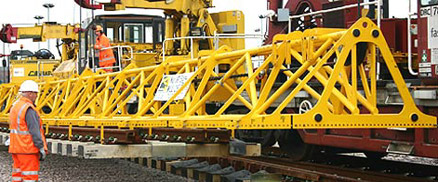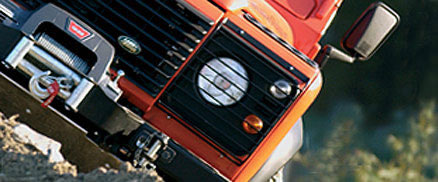June 22nd, 2010
The Pandrol® Fastclip is a new and revolutionary concept in rail fastening systems. It was computer developed to meet both current and future requirements of high speed, heavy haul and rapid transit operations. The Pandrol Fastclip system completely addresses
the need for fast, efficient track installation and reduced maintenance costs. The Pandrol Fastclip has met or exceeded every test and in-service performance demand. It is
pre-installed on concrete ties with pad and insulators in place, ready for track installation. Installation costs and long-term maintenance costs are significantly reduced.
Features
- All components pre-assembled on concrete ties
- Fast, fully mechanized installation and removal
- All components remain on the tie during rail change out or de-stressing
- Three positive locked positions
- Exceptional durability
- Excellent gage retention
- Exclusive two-piece insulators promote exceptionally long insulator life
- Larger bearing area of side post insulator distributes high lateral forces in curves
- Low stress, low profile design provides extended service life
- Can be used for turnouts
- No metal-to-metal contact at the clip/rail interface
- Hand tools available for manual installation
- Twin-stem or single-stem shoulder designs available
Installation and maintenance savings
The Pandrol® Fastclip system is pre-assembled at the tie manufacturer’s plant. Ties arrive at the job site with all components held securely in place. The clips, complete with toe insulators, have been pressed into the rail-ready position, where they hold the side post insulators and pads in place. Because of this railroads and contractors have realised significant installation savings. And that is just the beginning. The low-stress clip and dual insulator design result in extended component life and notable maintenance savings.
Posted in Arbil Rail |
May 23rd, 2010
Special precautions need to be taken when working trackside with live electric cables. If you are involved with repair or are responsible for maintaining cables special precautions must be taken at all times to ensure employee safety. Once the cable has been made dead and then connected to earth at the point of supply, the cable is then cut, usually by a hacksaw or cable cutters.
In order to enable the spiking operation to be carried out in perfect safety, a cable spiker tool needs to be used as it has the great advantage that it can be remotely controlled at the moment of firing by means of a lanyard (rope) release. The operator using the spiker can stand at a point of safety and if accidentally a “live” cable is spiked, the damage will only be local to the cable. As the speed of penetration of the spiking punch is so rapid, it has been found in practice that even if a “live” cable is spiked, usually no damage to the cable spiker results. If however, the fault current happens to be extremely high, it may be that the actual spiking punch itself may suffer, but yet be capable of tripping a normally operating breaker. An added feature of the cable spiker is that the wide punch shears the cable partially or totally, depending on the cable size, hence reducing additional cable cutting effort.
The cable spiker is suitable for use with all types and voltages of power cable including single and multiple conductor laminated, polymeric, elastomeric, unshielded, shielded, concentric neutral, interlock armoured, steel wire armoured, leaded covered etc. designs in either fixed or portable installations.
The cable spiker is a quality durable tool designed to positively electrically ground out any required power cable for definite manpower accident prevention and life saving to anybody working with live cables.
Posted in Arbil Rail |
May 7th, 2010
Gravity can kill but you can defy it. Using a fall protection system can prevent any injuries or fatalities. Falls from heights are one of the leading causes of serious injury and death at the work place. Analysis of all industrial accidents usually highlights inappropriate working conditions as a principal factor. In the case of working at heights, the consequences are immediate and serious, resulting in major disability or death. Approximately one in seven work place fatalities are due to a fall from heights.
The TurboLite PFLs are extremely lightweight and compact as well as being self retracting providing an incredible 6-foot of working capacity. The built-in swivel of the units prevents the lifeline from twisting and binding inside the unit and permits movement in multiple directions for greater mobility. The high-strength impact-resistant nylon housing of the TurboLite units provides maximum durability and protection to the internal components.
The braking mechanism, power spring and shaft are all constructed of high-quality corrosion resistant stainless steel. The lanyard webbing has a 1-inch wide Veteran core and polyester outer jacket that is specially engineered for maximum abrasion resistance and durability. No annual factory recertification is required. The capacity rating of the Twin Turbo system is 400 lbs., total weight of worker and tools.
This fall Protection Systems:
- Eliminates the need for different fall protection equipment to address changes in fall clearance
- Reduces risk because workers at height are using proper equipment when fall clearance changes
- Increases productivity by keeping workers on the job longer
- Keeps safety costs in line as it is competitively priced with shock-absorbing lanyards
This Fall Protection System is ideal for people working at height as it is small and lightweight. If a fall should occur whilst using this fall Protection System then the worker will be suspended a short distance below the area they were working making rescue easier and safer for both the worker that has fallen and the rescuer. Using this particular Fall Protection system eliminates any possibility of tripping hazards that are usually associated with lanyards.
The Twin Turbo Fall Protection system is widely used and has greatly reduced the risk of sustaining injury whilst working overhead.
Posted in Arbil Rail |
March 29th, 2010
Before using a Norton track jack the operator should be familiar in its use. When raising a load operate the lever up and down. The jacks will raise the load one notch for each lever down stroke. The rack cannot be ratcheted out of the base because it is designed to stop when raised to its top limit.
To trip the jacks, raise the lever as high as it will go and disengage the short pawl by pulling on the pawl knob as far as it will go in the direction of the socket lever. Lower lever slightly to allow the short pawl to become locked against the long pawl, then release the short pawl and continue to lower lever until the long pawl is disengaged from the rack which trips the jack.
The following precautions and procedures should be followed when operating a Norton track jack:
- always visually inspect the jack before each shift or each use, whichever is less frequent.
- determine if the load is within the load rating of the jack otherwise it should not be used
- support the jacks firmly at the base in such a manner so that that it cannot shift under the load it is carrying.
- use shims or constraints to prevent slippage of the base or the load.
- use an operating lever of correct size and make sure the operating lever is properly seated in its socket.
- do not straddle the operating lever.
- remove operating levers when not in use to avoid dislocation of the jack and reduce the tripping hazard.
- take precaution to assure that all personnel are clear of the load before tripping.
- assure that sufficient swing area is available for the operating lever.
- avoid off-centre loading of jacks.
- lubricate the jack generously with grease frequently. This is recommended every 50 cycles. Apply the grease to bushing through holes at ends, to front and sides of the rack when extended and to the front of the base around the slot for the rack toe.
Posted in Arbil Rail |
February 23rd, 2010
The new jack on the block is the Pow’r Claw Track Jack. This jack has been specifically designed to reduce the risk of injury to the operator, notably back injuries. The Pow’r Jack is an extremely versatile piece of kit and is already setting new standards for safety and productivity amongst track maintenance crews around the world.
The Pow’r Claw came about after heavy use with track maintenance crews in the U.S. and Canada. The Pow’r Claw has a variety of features. The design of the tool is totally inverted which keeps out water and dirt from the jack increasing longevity and performance of the Jack. The pistons are constructed from hard chrome, a resistance to corrosion increasing Jack life.
The biggest feature of the Pow’r Claw Track Jack is operator safety. When this Track Jack was designed it was designed specifically for one man operation – operators whose daily job involved lifting heavy loads such as concrete ties. With a low lever bar force this greatly reduces the risk of injury to the back. The bar is designed not to kick back and injure the operator should it be accidentally released.
Benefits of the Pow’r Claw Jack
- Although light weight weighing only slightly more than a mechanical jack it is extremely heavy duty.
- It can be operated in a horizontal position making it easier for lining or gauging track.
- Offers precise lowering and lifting that is accurate.
- It has a large solid base which provides more surface area and greater support in soft ballast.
- Low handle effort allows one man operation easily for lifting heavy loads such as concrete tie sections.
- Has a safety key lock which prevents the jack toe body from swivelling giving safe and stable support.
- Can be used as jack from either the top or toe.
- Has a removable pump which allows the self contained Jack to be converted to a remote style.
Posted in Arbil Rail |


